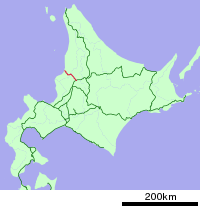Rumoi Main Line
The Rumoi Main Line (留萌本線, Rumoi-honsen) is a Japanese railway line in Hokkaido operated by Hokkaido Railway Company (JR Hokkaido) which connects Fukagawa Station in Fukagawa and Rumoi Station in Rumoi.
| Rumoi Main Line | |||
|---|---|---|---|
A single-car DMU on the Rumoi Main Line in September 2011 | |||
| Overview | |||
| Type | Regional rail | ||
| Locale | |||
| Termini | Fukagawa Rumoi | ||
| Operation | |||
| Opened | 23 October 1910 | ||
| Owner | JR Hokkaido | ||
| Technical | |||
| Line length | 50.1 km (31.1 mi) | ||
| Track gauge | 1,067 mm (3 ft 6 in) | ||
| |||
On 19 November 2016, JR Hokkaido's President announced plans to further rationalise the network by up to 1,237 km, or approximately 50% of the network,[1] including closure of the remaining section of the Rumoi Main Line (the Rumoi to Mashike section closed on 4 December 2016).
Stations
Stops legend: ●: All trains stop, ◆: some trains stop, ▼: some down trains pass, ▲: some up trains pass
| No. | Station name | Japanese | Between (km) |
Distance (km) |
Stop | Transfers | Location |
|---|---|---|---|---|---|---|---|
| A24 | Fukagawa | 深川 | 0.0 | ● | ■ Hakodate Main Line | Fukagawa | |
| Kita-Ichiyan | 北一已 | 3.8 | 3.8 | ▼ | |||
| Chippubetsu | 秩父別 | 5.0 | 8.8 | ▼ | Chippubetsu, Uryū District | ||
| Kita-Chippubetsu | 北秩父別 | 2.4 | 11.2 | ◆ | |||
| Ishikari-Numata | 石狩沼田 | 3.2 | 14.4 | ● | Numata, Uryū District | ||
| Mappu | 真布 | 3.4 | 17.8 | ◆ | |||
| Ebishima | 恵比島 | 2.9 | 20.7 | ▼ | |||
| Tōgeshita | 峠下 | 7.6 | 28.3 | ● | Rumoi | ||
| Horonuka | 幌糠 | 6.2 | 34.5 | ◆ | |||
| Fujiyama | 藤山 | 5.5 | 40.0 | ◆ | |||
| Ōwada | 大和田 | 4.2 | 44.2 | ▲ | |||
| Rumoi | 留萌 | 5.9 | 50.1 | ● |
Closed section
| Station name | Japanese | Between (km) |
Distance (km) |
Location |
|---|---|---|---|---|
| Rumoi | 留萌 | 5.9 | 50.1 | Rumoi |
| Segoshi | 瀬越 | 2.1 | 52.2 | |
| Reuke | 礼受 | 4.0 | 56.2 | |
| Afun | 阿分 | 1.3 | 57.5 | Mashike, Mashike District |
| Nobusha | 信砂 | 2.7 | 60.2 | |
| Shaguma | 舎熊 | 0.8 | 61.0 | |
| Shumombetsu | 朱文別 | 1.7 | 62.7 | |
| Hashibetsu | 箸別 | 1.3 | 64.0 | |
| Mashike | 増毛 | 2.8 | 66.8 |
History
The initial section of the line, between Fukagawa and Rumoi opened on 23 October 1910, and was extended to Mashike on 5 November 1921.[2] The line was reclassified as a "main line" from 10 October 1931.[2] With the privatization of Japanese National Railways (JNR) on 1 April 1987, the line came under the control of JR Hokkaido.[2]
Closure plans
On 10 August 2015, JR Hokkaido informed the mayors of Rumoi and Mashike of its plans to close the 16.7 km section of the line from Rumoi and Mashike in 2016.[3] In April 2016, it was officially announced that the section from Rumoi to Mashike would close, and the last service operated on 4 December.[4]
References
- "JR Hokkaido says it can't maintain half of its railways". 10 May 2013.
- Ishino, Tetsu, ed. (1998). 停車場変遷大辞典 国鉄・JR編 [Station Transition Directory - JNR/JR] (in Japanese). I. Japan: JTB. pp. 83, 129. ISBN 4-533-02980-9.
- 留萌線(留萌~増毛間)の鉄道事業廃止について [Closure of Rumoi Line between Rumoi and Mashike]. Tetsudo Hobidas (in Japanese). Japan: Neko Publishing Co., Ltd. 10 August 2015. Retrieved 11 August 2015.
- JR留萌線留萌―増毛間12月4日に廃止 増毛町が同意 [Mashike agrees to closure of JR Rumoi Line between Rumoi and Mashike on 4 December]. Doshin Web (in Japanese). Japan: The Hokkaido Shimbun Press. 8 April 2016. Archived from the original on 8 April 2016. Retrieved 14 April 2016.
| Wikimedia Commons has media related to Rumoi Main Line. |
